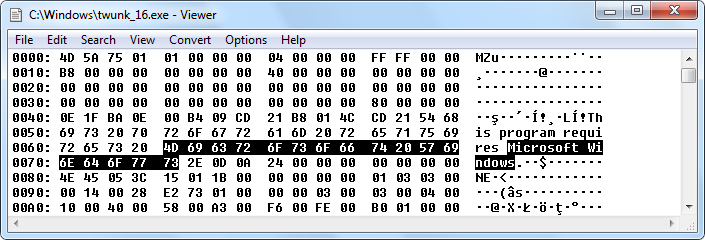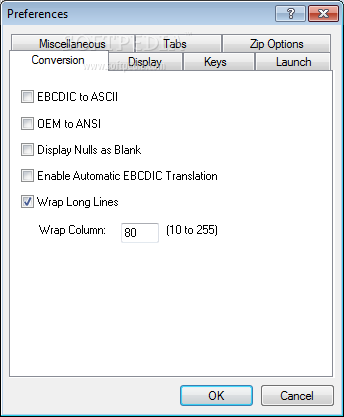Ebcdic File Viewer
- Edit any file text, ebcdic, data, binary, hex and more. File type text encoding settings. Vedit converts between many file types. Convert files encoding with aap salamander. Convert your text files from any encoding to any other one. This is the resu on my netbean s ide console. Appendix f ascii and ebcdic characters optimum data inc.
- This is a library built from two C# source files and the ebcdic.dat file generated by the reader. This library is all most users will need. More details are provided below. A test program This is a console application built from a single C# source file and requiring the library described above.
- Ebcdic is a Python package adding additional EBCDIC codecs for data exchange with legacy system. It works with Python 2.7 and Python 3.4+. EBCDIC is short for Extended Binary Coded Decimal Interchange Code and is a family of character encodings that is mainly used on mainframe computers.
- WnBrowse - File Viewer. WnBrowse is a multifunction ASCII, EBCDIC and Hex file viewer. View large files, including files within zip archives. Search for text, hex and UNICODE strings. Print the entire file or a selected portion. Integrated with the Windows Explorer for two-click file browsing. Works with all versions of Windows.
In the first article in this series, we introduced EBCDIC code pages, and how they work with z/OS. But z/OS became more complicated when UNIX Systems Services (USS) introduced ASCII into the mix. Web-enablement and XML add UTF-8 and other Unicode specifications as well. So how do EBCDIC, ASCII and Unicode work together?
If you are a mainframe veteran like me, you work in EBCDIC. You use a TN3270 emulator to work with TSO/E and ISPF, you use datasets, and every program is EBCDIC. Or at least that's the way it used to be.

EBCDIC was devised in 1963 and 1964 by IBM and was announced with the release of the IBM System/360 line of mainframe computers.It is an eight-bit character encoding, developed separately from the seven-bit ASCII encoding scheme.

UNIX Systems Services (USS) has changed all that. Let's take a simple example. Providing it has been setup by the Systems Programmer, you can now use any Telnet client such as PuTTY to access z/OS using telnet, SSH or rlogin. From here, you get a standard UNIX shell that will feel like home to anyone who has used UNIX on any platform. telnet, SSH and rlogin are ASCII sessions. So z/OS (or more specifically, TCP/IP) will convert everything going to or from that telnet client between ASCII and EBCDIC.
Like EBCDIC, expanded ASCII has different code pages for different languages and regions, though not nearly as many. Most English speakers will use the ISO-8859-1 ASCII. If you're from Norway, you may prefer ISO-8859-6, and Russians will probably go for ISO-8859-5. In UNIX, the ASCII character set you use is part of the locale, which also includes currency symbol and date formats preferred. The locale is set using the setenv command to update the LANG or LC_* environment variables. You then set the Language on your Telnet client to the same, and you're away. Here is how it's done on PuTTY.
From the USS shell on z/OS, this is exactly the same (it is a POSIX compliant shell after all). So to change the locale to France, we use the USS setenv command: The first two characters are the language code specified in the ISO 639-1 standard and the second two the country code from ISO 3166-1.
Converting to and from ASCII on z/OS consumes resources. If you're only working with ASCII data, it would be a good idea to store the data in ASCII, and avoid the overhead of always converting between EBCDIC and ASCII.The good news is that this is no problem. ASCII is also a Single Byte Character Set (SBCS), so all the z/OS instructions and functions work just as well for ASCII as they do for EBCDIC. Database managers generally just store bytes. So if you don't need them to display the characters in a readable form on a screen, you can easily store ASCII in z/OS datasets, USS files and z/OS databases.
The problem is displaying that information. Using ISPF to edit a dataset with ASCII data will show gobbldy-gook - unreadable characters. ISPF browse has similar problems.
With traditional z/OS datasets, there's nothing you can do. However z/OS USS files have a tag that can specify the character set that used. For example, look at the ls listing of the USS file here:
You can see that the code page used is IBM-1047 - the default EBCDIC. The t to the left of the output indicates that the file holds text, and T=on indicates that the file holds uniformly encoded text data. However here is another file:
The character set is ISO8859-1: extended ASCII for English Speakers. This tag can be set using the USS ctag command. It can also be set when mounting a USS file system, setting the default tag for all files in that file system.
This tag can be used to determine how the file will be viewed. From z/OS 1.9, this means that if using ISPF edit or browse to access a dataset, ASCII characters will automatically be displayed if this tag is set to CCSID 819 (ISO8859-1). The TSO/E OBROWSE and OEDIT commands, ISPF option 3.17, or the ISHELL interface all use ISPF edit and browse.
If storing ASCII in traditional z/OS datasets, ISPF BROWSE and EDIT will not automatically convert from ASCII. Nor will it convert for any other character set other than ISO8859-1. However you can still view the ASCII data using the SOURCE ASCII command. Here is an example of how this command works.
Some database systems also store the code page. For example, have a look at the following output from the SAS PROC _CONTENTS procedure. This shows the definitions of a SAS table. You can see that it is encoded in EBCDIC 1142 (Denmark/Norway):
DB2 also plays this kind of ball. Every DB2 table can have an ENCODING_SCHEME variable assigned in SYSIBM.TABLES which overrides the default CCSID. This value can also be overridden in the SQL Descriptor Area for SQL statements, or in the stored procedure definition for stored procedures. You can also override specify CCSID when binding an application, or in the DB2 DECLARE or CAST statements.
Or in other words, if you define tables and applications correctly, DB2 will do all the translation for you.
Unicode has one big advantage over EBCDIC and ASCII: there are no code pages. Every character is represented in the same table. And the Standards people have made sure that Unicode has enough room for a lot more characters - even the Star Trek Klingon language characters get a mention.
Ebcdic File Viewer Download
But of course this would be too simple. There are actually a few different Unicodes out there:
- UTF-8: Multi-Byte character set, though most characters are just one byte. The basic ASCII characters (a-z, A-Z, 0-9) are the same.
- UTF-16: Multi-byte characters set, though most characters are two bytes.
- UTF-32: Each character is four bytes.
Most high level languages have some sort of Unicode support, including C, COBOL and PL/1. However you need to tell these programs that you're using Unicode in compiler options or string manipulation options.
z/OS also has instructions for converting between Unicode, UTF-8, UTF-16 and UTF-32. By Unicode, IBM means Unicode Basic Latin: the first 255 characters of Unicode - which fit into one byte.
A problem with anything using Unicode on z/OS is that it can be expensive in terms of CPU use. To help out, IBM has introduced some new Assembler instructions oriented towards Unicode. Many of the latest high level language compilers use these when working with Unicode instructions - making these programs much faster. If you have a program that uses Unicode and hasn't been recompiled for a few years, consider recompiling it. You may see some performance improvements.
z/OS is still EBCDIC and always will be. However IBM has realised that z/OS needs to talk to the outside world, and so other character encoding schemes like ASCII and Unicode need to be supported - and are.
z/OS USS files have an attribute to tell you the encoding scheme, and some databases systems like SAS and DB2 also give you an attribute to set. Otherwise, you need to know yourself how the strings are encoded.

This second article has covered how EBCDIC, ASCII and Unicode work together with z/OS. In the final article in this series of three. I'll look at converting between them.
Ebcdic File Viewer Free
If V does not display the EBCDIC file correctly, you can click on EBC on the status bar (or select EBCDIC Options from the View menu) to specify the correct file format.
EBCDIC files are usually in one of 4 formats.
Carriage Return Delimited
These files are just like ASCII files. That is, each line is terminated by a carriage return (or carriage return + line feed). The only difference is that the file contains EBCDIC characters instead of ASCII characters.
To display these types of files the No Formatting (Display as EBCDIC file with CR/LF) option should be enabled.
If some EBCDIC characters are not displayed correctly, you can modify the EBCDIC to ASCII mapping in the EBCDIC tab of Preferences.
Fixed Length Records (RECFM=F)
Each line (or record) in the file consists of a fixed number of characters. To view these files, enable the RECFM=F option and enter the fixed record length in the LRECL field.
Click here for further details on viewing RECFM=F files.
Variable Length Records (RECFM=V/VB)
These files consist of variable length lines (or records). Each record is preceded by a 4 byte record descriptor which specifies the record length. V will automatically decode the records and display the lines as if they were delimited by a carriage return.
Undefined Format (RECFM=U)
By strict definition, the format of these files is Undefined (or Unknown). However in V, the meaning is slightly different. Click here for further details.
Carriage Control (CCTYPE)
Click here for details on Carriage Control.

Use ASCII Character Set
By default, EBCDIC RECFM files consist of EBCDIC characters. Enable this option if the file consists of ASCII characters.
Trailing Spaces
It is common for records/lines in EBCDIC files to be padded with trailing spaces - especially when files with variable length records are stored as RECFM=F.
Enable the Ignore Trailing Spaces option if you do not want the trailing spaces displayed.